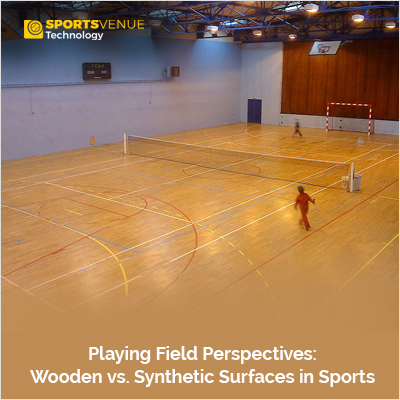Playing Field Perspectives: Wooden vs. Synthetic Surfaces in Sports

Sports fields, be it for football, soccer, hockey, or tennis, play a crucial role in shaping athletes' performance and experiences. Among the many factors that influence these dynamics, the choice of playing surface stands out as a significant one. Traditionally, wooden surfaces have been prevalent in sports like basketball and indoor arenas, while synthetic surfaces have gained popularity in outdoor sports like football and tennis. In this article, we delve into the perspectives surrounding wooden and synthetic surfaces in sports, exploring their advantages, drawbacks, impact on performance, and considerations for athletes and sports organizations.
Evolution of Playing Surfaces
The evolution of playing surfaces in sports mirrors advancements in material science, engineering, and player safety. Wooden surfaces have a long history, dating back to early sports venues where hardwood floors provided durability and a consistent bounce for sports like basketball. These surfaces were preferred for their natural feel, shock absorption, and ability to withstand rigorous play.
On the other hand, synthetic surfaces emerged as a modern alternative, offering enhanced durability, weather resistance, and customization options. Artificial turf, for instance, revolutionized outdoor sports by providing a consistent playing surface regardless of weather conditions. This paved the way for year-round playability and reduced maintenance costs for sports facilities.
Performance Considerations
The choice between wooden and synthetic surfaces often boils down to performance considerations. Wooden surfaces, with their natural texture and bounce, are favored in sports like basketball and indoor volleyball, where grip and agility are crucial. The organic feel of wood can enhance ball control, footwork, and overall playing experience for athletes.
| Also Read: Optimizing Performance with Wooden and Synthetic Surfaces in Sports |
Conversely, synthetic surfaces offer advantages in terms of uniformity, shock absorption, and traction. Artificial turf, specifically designed for outdoor use, provides consistent ball roll and bounce, making it suitable for sports like football and soccer, where speed and precision play a significant role. Moreover, synthetic surfaces can be tailored to mimic natural grass or provide specific performance characteristics, catering to different sports requirements.
Safety and Injury Prevention
Player safety is paramount in sports, and playing surfaces play a vital role in injury prevention. Wooden surfaces, while offering a natural feel, may pose risks such as splinters, unevenness, and impact-related injuries. Proper maintenance and inspection are crucial to ensuring the safety of wooden playing fields.
On the other hand, synthetic surfaces are engineered to minimize injury risks, with features like shock absorption, evenness, and non-abrasive textures. Artificial turf, for instance, is designed to reduce impact forces on players, lower the risk of slips and falls, and provide a consistent playing experience. Additionally, synthetic surfaces can be designed with antimicrobial properties to mitigate health concerns associated with moisture retention.
Environmental Impact
As sustainability becomes a key focus across industries, the environmental impact of playing surfaces cannot be overlooked. Wooden surfaces, sourced from renewable resources like hardwood trees, have a relatively lower carbon footprint compared to synthetic materials. However, concerns arise regarding deforestation and habitat loss associated with intensive logging for sports flooring.
Synthetic surfaces, while offering durability and weather resistance, are often made from non-biodegradable materials like polyethylene and rubber. The disposal of worn-out synthetic turf poses challenges in terms of recycling and environmental conservation. Efforts are underway to develop eco-friendly alternatives and recycling programs to mitigate the environmental impact of synthetic playing surfaces.
Maintenance and Longevity
Maintenance requirements and longevity are key factors influencing the choice between wooden and synthetic surfaces. Wooden floors demand regular upkeep, including sanding, refinishing, and moisture control to maintain their performance and appearance. Proper maintenance extends the lifespan of wooden surfaces and ensures optimal playing conditions.
Synthetic surfaces, although initially expensive to install, offer long-term cost savings due to lower maintenance needs. Routine grooming, infill replenishment, and periodic inspections are recommended to maximize the lifespan of artificial turf. Advances in synthetic turf technology have also led to improved durability, UV resistance, and drainage capabilities, enhancing the longevity of these playing surfaces.
Player Preferences and Adaptability
Player preferences play a significant role in the acceptance and adoption of playing surfaces. Athletes may have varying preferences based on their sport, playing style, and personal experiences. Wooden surfaces, with their traditional appeal and natural feel, are often preferred in indoor sports settings where grip and precision are paramount.
Synthetic surfaces, on the other hand, offer versatility and adaptability to different sports and weather conditions. Many outdoor sports facilities have transitioned to artificial turf due to its all-weather playability, low maintenance, and consistent performance. Player feedback and comfort are essential considerations when choosing between wooden and synthetic surfaces to ensure optimal playing conditions and performance outcomes.
Technological Advancements
Technological advancements have significantly impacted the design and performance of playing surfaces in sports. Innovations such as shock-absorbing underlays, customizable infills, and synthetic fibers with enhanced durability have revolutionized synthetic turf systems. These advancements aim to replicate the natural feel and performance of grass while offering superior durability and playability.
Similarly, wooden flooring technologies have evolved to incorporate features like moisture resistance, impact absorption, and customizable finishes. Engineered wood products and hybrid flooring systems combine the benefits of natural wood with enhanced durability and maintenance ease, catering to the evolving needs of sports facilities and athletes.
Future Trends and Considerations
Looking ahead, the future of playing surfaces in sports will likely be shaped by sustainability, technology, and athlete-centric design. Eco-friendly materials, recyclable components, and energy-efficient manufacturing processes are expected to gain prominence in the development of synthetic surfaces. Similarly, advancements in wooden flooring systems will focus on sustainability, performance optimization, and user comfort.
Athlete feedback, data analytics, and biomechanical studies will continue to inform playing surface design, ensuring optimal performance, injury prevention, and player satisfaction. Hybrid surfaces combining natural and synthetic elements may emerge as a viable option, offering the benefits of both materials while minimizing drawbacks.
In conclusion, the choice between wooden and synthetic surfaces in sports involves a nuanced consideration of performance, safety, sustainability, and player preferences. Each type of surface brings unique advantages and challenges, shaping the playing experience and outcomes for athletes. As technology advances and sustainability becomes a priority, the future of playing surfaces will likely witness innovations that prioritize performance, safety, and environmental responsibility.





